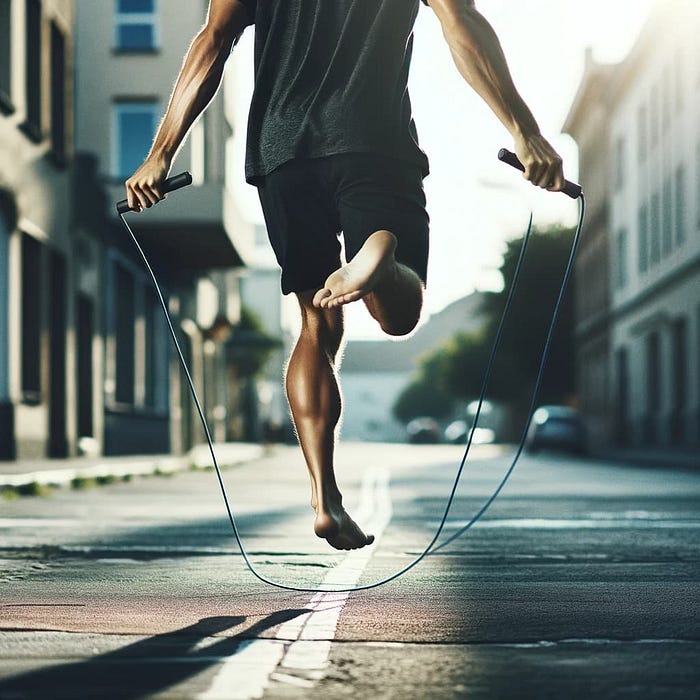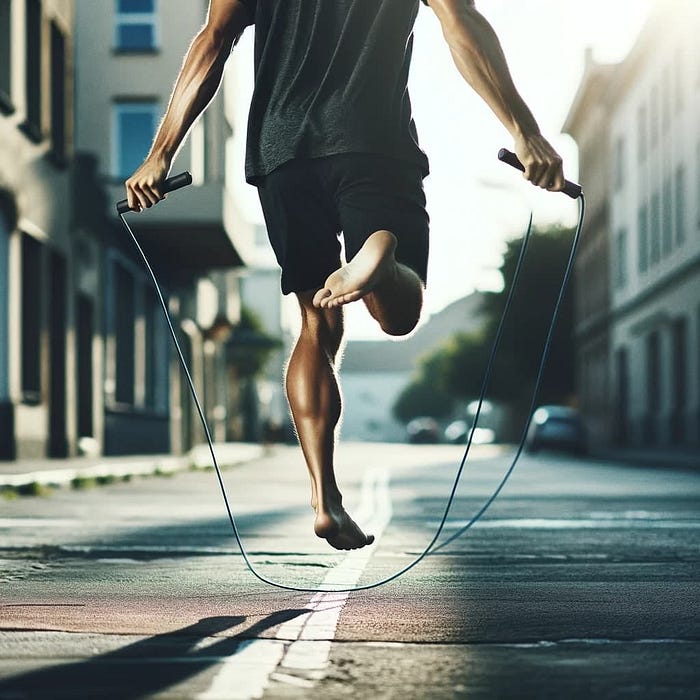
Why jump rope isn’t already touted as a leading running drill tool is completely beyond me. But then again…
I’m by no means an “experienced runner” — having started running in 2021 at the age of 34. So, at the time of this writing, about 3 years.
Despite this, I managed to silver-medal my age group in my first race ever.
And it was a 10k. And I was wearing barefoot-shoes.
And I had only been running before that race for about 3 months.
How the heck did I manage to pull this off?
The answer eluded me for a while. Then I remembered — ah, I’ve been jumping rope nearly every day for 2 years.
But how do those connect?
But first, why the heck would some guy start jumping rope at age 32?
About 2 years before I started running, I took up jump rope really just as a fun outdoor hobby.
Even though I was pretty inactive and a bit overweight, that’s not the reason I started skippin’.
One day, I came across some footage of boxer Lulu Hawton doing some jump rope training.
In addition to her seemingly effortless rope handling skills and rhythmic footwork, what caught my eye was a giant grin that spread across her face about 45 seconds into the video. While she was probably skipping to warm up for a match or a training session, something was abundantly clear.
She was having a blast.
And this was from a prize fighter! None of the usual boxer mean-mugging — she looked more like a kid on a carousel.
So, after buying a $10 jump rope on Amazon, I took to the driveway in my swim trunks (yes, I was so inactive, I didn’t own gym shorts).
And…whoo, did I suck.
After a few months of making puddles of sweat in my driveway as well as wheezing sounds so loud that I’m surprised the neighbors didn’t whistle EMS, I eventually got pretty decent at it.
And I lost about 45 pounds in 6 months — probably also from making some lifestyle changes merely to make jump rope less of a slog. Not the original plan, but hey, not too shabby.
After about a year, I found myself constructively critiquing other people’s beginner jump rope videos.
- “Unlock your boxer skip. Then you’ll be able to skip forever without getting tired.”
- “Here’s how to do Double-Unders, though they’re overrated.”
- “You’re skipping like it hurts. Relax and skip easy. Smile every once in a while and you’ll feel it all over.”
But how did that turn into running?
Though jumping rope is inherently enjoyable, 30-minute skipping sessions of staring at the wall without something in your headphones can be a bit drab.
One fateful day, about 2 years into being student of the jump rope, I began listening to the book Born to Run: A Hidden Tribe, Superathletes, and the Greatest Race the World Has Never Seen by Christopher McDougall.
Even before I got to the end of the book, running — just like jump rope — sounded fun.
Yeah, I know that sounds counterintuitive — unless you’ve read the book.
“I knew aerobic exercise was a powerful antidepressant, but I hadn’t realized it could be so profoundly mood stabilizing and — I hate to use the word — meditative. If you don’t have answers to your problems after a four-hour run, you ain’t getting them.”
Ok, ok — I’ll bite.
I proceeded to dive into all of the normal “Couch to 5k” running programs I could find and took my jump rope to a nearby park with a 1k walking path — sprinkling in running between jump rope sessions.
But something wasn’t adding up.
There was a lot of advice about walk-running to build endurance until one could run a block, two blocks, a mile.
Not to brag, but I wasn’t experiencing most beginner snags.
“Ah, I know why — I did most of my newbie wind-sucking two years ago!”
This isn’t to say I wasn’t still periodically sucking wind but after two years of consistent boxer skips and double-unders, getting gassed felt like part of the fun and not a medical emergency.
I also felt much springier than the average beginning runner — able to run for miles all over the city in the most minimal of footwear.
And so, I tried my hand at my first race — a donut-themed 10k. And silvered in my age group.

(Ok, there was only two of us…but my time was still respectable. 😂)
Running became an amazingly freeing activity, like getting my driver’s license for my legs.
But I still didn’t understand why running was coming easier to me than the average newcomer.
Digging still deeper, I unearthed another exciting revelation — this time from multi-decade sub-3-hour Boston Marathon runner and one of the foremost running experts on the planet, Dr. Mark Cucuzzella.
“Running with a jump rope is also an amazingly simple drill for posture, balance, and rhythm.”
In other words — form. Overall technique.
Digging a little keeper and experimenting on myself, I discovered just how similar proper running technique and proper jump rope technique were.
Both require:
- An upright, chest-leading, elbows-back, joint-stacked posture
- A soft mid-foot landing directly under your pelvis
- A quick loading and unloading of “leg springs” from your tendons and ligaments to reduce “stickiness” and wasted energy
- A proper supination (roll out) followed by a quick pronation (roll in) of the feet to help launch one’s body
- A steady core without dropping hips from side to side to reduce energy “leakage”
And so many other commonalities. The list unraveled before me on every run.
And like running, without proper technique, jumping rope just doesn’t work — though the consequences are different.
For a jump roper, due to the lower impact, the risk of injury is quite minimal.
Most newbie rope slingers will report sore calves, slightly tender Achilles tendons, and the odd shin splint if they go full Rocky at it. No need to worry, though — most of these injuries see themselves out as the skipper becomes more experienced.
However, for runners, the injury story is more severe.
The next time you’re at a park with a good path, take a seat on a bench and watch the runners. See if you can spot folks reaching far out in front of them with straightened legs — smashing heels into the pavement.
This style of running results in everything from screaming knees, plantar fasciitis, lower back pain, to hips issues.
But why do all of these occur to new runners, but rarely to new jump ropers?
Most new runners commit a major physiological no-no when they begin their running journey: they treat running like fast, aggressive, airborne walking.
“Well, what is it supposed to be?”
Synchronized jumping.
Simply put, proper running is nothing more than a series of coordinated single leg jumps through space with each landing compressing the springs for the next stride.
To compare this synchronized jumping to the aggressive airborne walking of heel-led running, you can test these in just a few seconds.
Step 1: Stand up.
Step 2: Kick off your shoes.
Step 3: Jump up and down three times.
How did you land?
Probably on your mid-foot, knee bent slightly, with your weight stacked above your pelvis.
And did you use your compressed “leg springs” to launch you into the following two jumps?
Oddly enough, if you were to add a jump rope to this, you would on your way to spinning side swings like Lulu Hawton.
If you were to take this same technique one foot at a time moving forward, you would be running in a way that increases speed, preserves stamina (springs!), and drastically decreases your likelihood of injury.
Let’s try the same test with a few tweaks.
This time, jump, but land on your heels.
Your knees probably remained fairly straight and you felt the impact in your ankles, knees, hips, and possibly even your lower back.
Now, imagine attempting to jump rope this way.
It simply doesn’t work.
Not only would there be no second jump due to the lack of spring but the pain would stop you in your tracks — even in cushioned shoes.
But if jump rope technique and proper running technique are nearly identical, what are aggressive heel landings doing in running?
While a jump roper landing on their heels would resemble Frankenstein’s monster in an express lane to an orthopedist, this is how many people perform the aggressive airborne walk — aka, a heel-striking, over-striding run.
But why do we run this way? Well, our shoes let us get away with it.
Thick heel cushioning and a bit of forward momentum do a great job of masking the pain of repeated blows against every joint up the chain — for a while, anyway. Eventually, the chickens come home to roost in the form of stress fractures, meniscus tears, plantar fasciitis, “runner’s knee,” IT-band syndrome, and more.
Not to brag (and maybe to knock on some wood), I have never experienced any of these injuries in my three years of running.
Is this because I’m some kind of running genius with all of the cheat codes? Haha, I wish! It’s simply sheer luck that I started out with jumping rope before running — an activity that shares the same injury-preventing techniques.
So, are the shoes totally to blame? No.
It is possible to run with proper form in shoes with raised, cushioned heels. But it’s not as easy.
When your heel is totally cushioned, you will be able to run with a heel strike in the same way you can hit your head against a brick wall while wearing a football helmet. And in both instances, it will eventually become less about the forces outside of the foam and more about the forces inside the cushion against each other that do the most damage.
“So, how can getting a jump rope help me become a better runner?”
Jump rope is a tremendous training tool for runners for the same reason why running barefoot can also be helpful — the feedback is immediate.
Though running with inefficient and injurious form is possible, the feedback from doing so isn’t so immediate. When it comes to jumping rope, however, you won’t get through too many skips if you don’t learn to utilize the springs in your legs. The rope doesn’t pull punches.
So, get a rope and get started.
If you’re new to jump rope, I would recommend acquiring two pieces of equipment.
Firstly, find a jump rope with a little bit, but not too much, weight to it. The weight will help you feel the position of the rope during it’s entire rotation and remain in better sync with your wrist spins
My favorite rope for this purpose is a 7mm PVC model called the Hererope, which costs a whopping $15. If you find this to be too thick or heavy, a cheap 5mm PVC model will work as well.
Secondly, to protect your rope and provide a nice jumping surface, I would recommend a large foam-rubber exercise mat. My favorite is a massive 78” mat for $32 — which is probably the cheapest jump rope mat you will find.
When it comes to footwear, barefoot is ideal. This will help strengthen and mobilize your feet — including your likely overly-supported neglected arches.
And just how does one begin to jump rope?
- Keep a tall posture — imagining a string pulling you up from the crown of your head.
- Your chest should open, elbows back, hands about a fist’s width from your pockets.
- Jump from the balls of your feet, only high enough to clear the rope. When landing, let the skin of your heels “kiss” the floor — touching without taking on weight.
- Keep your knees slightly bent, using every landing to load your springs for the next take-off.
- Keep the cadence quick to maximize spring recoil. To help, listen to a song that’s at about 160 beats per minute, such as the song “Hey Ya” by Outkast (or a song of similar tempo) to get a feel for the speed for skipping rope. (For running, many recommend using “Rock Lobster” by the B-52s for cadence tempo reference.)
Start with short seasons hopping with both feet — maybe 30 seconds on, 30 seconds rest. Aim for minimal muscular activation, instead, using the recoil of your tendons and ligaments for suspension and launch as much as possible.
From jumping with both feet, move onto learning an alternating leg bounce — essentially a jog skip. Right, left, right, left — all while keeping an imaginary belt level with the horizon.
By now, you’re essentially running in place with an extremely efficient technique.
Now, apply your jump rope skills to your running!
This is going to seem quite bizarre, but it is possible (and even beneficial) to take your jump rope for a run.

- Start skipping rope on a road or path with the alternating leg bounce. Remember to keep your elbows back, shoulders relaxed, head pulled up as if tugged skyward by a string from your crown and your imaginary belt level with the horizon.
- Then, as though leaning forward just enough to give someone a kiss or have an imaginary umbilical cord lightly tugged, begin to jump rope forward.
- Remember to continue to land and load on your mid-foot — aiming to keep your weight under your pelvis just like skipping rope. Landing on your heels will likely snag the rope and keep your foot on the ground too long.
- As you proceed with this, remember how it feels — the quick foot turnover, the posture, the recoil in your leg springs, the core stability, and the lightness of it.
- In the middle of doing this, simply toss the handles behind you and keep running as though it was still there — still pretending to spin the handles.
- At a comfortable stopping point, run back to your rope — now using your hands in a wood-chop motion to counter balance your leg bounces while keeping your pelvis (imaginary belt) level and stable.
And there you have it!
You may find it quite helpful to return to this drill once or twice a week. Also if you find your form slipping a bit or becoming slugging mid-run, feel free to skip imaginary rope to try to correct your technique mid-stride. It will restore lightness and springiness to your running.
I still find myself bringing my wrists to my pockets and spinning imaginary jump rope handles if I feel my technique is collapsing a bit or if my running is becoming less springy.
And remember, most importantly — have fun. 👍
